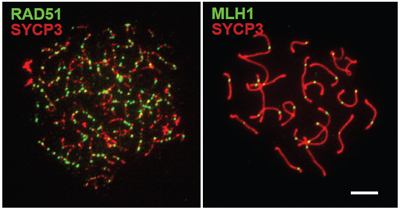Control mechanism guarantees correct formation of egg and sperm in mammals

07/03/2012
Humans suffer from a high index of aneuploidies, the presence of more or less than 46 chromosomes in each cell of an individual. An example is trisomy 21, the cause of Down Syndrome. This in part is due to errors produced during the formation of female gametes (eggs) in the cell division process known as meiosis when it combines with genetic material from the sperm (meiotic recombination).
During the whole gamete formation process multiple double-strand breaks of the DNA molecules take place. These breaks are repaired through a process called homologous recombination, which produces two new things, mainly genetic conversions, and to a lesser extent, chromosomal crossovers. It is estimated that only 10% of the DNA breaks in mammals are repaired as crossovers. However, even with such a low percentage, the presence of crossovers is essential for the correct formation of eggs and sperm. An incorrect number of crossovers can lead to eggs and sperm with an incorrect number of chromosomes which can later be the cause of aneuploidies. This fact explains that the process of meiotic recombination is highly regulated in order to guarantee the formation of a specific number of constant crossovers and the correct formation of gametes. Yeast and worms show to have mechanisms generally known as crossover homeostasis, which maintain a stable number of crossovers.
An article in Nature Cell Biology demonstrates that mammals also have mechanisms similars to crossover homeostasis which guarantee the correct formation of eggs and sperm. An experiment with genetically modified mice helped researchers observe that even when the number of DNA breaks carried out by each cell undergoing meiosis is modified, mice generate a constant number of crossovers in all individual cells. This mechanism is essential to ensure the correct formation of eggs and sperm, taking into account the great variability existing in the number of breaks produced in each cell when undergoing meiosis.
Researchers were interested in discovering is this mechanism has the same effect on the formation of human eggs. The reason for this is that while crossovers present in male gametes are quite constant, they vary greatly in female gametes. It is worth noting that a large part of human aneuploidies is caused by errors in the number of crossovers produced in the formation of eggs. Thus, results obtained suggest that a malfunctioning of the crossover homeostasis mechanisms could be involved in the genesis of aneuploidies in humans.
Image: Mouse spermatocytes with DNA double-strand break markers (RAD51) and crossover points (MLH1). SYCP3 marks the proteic axis on which chromosomes are assembled during meiosis. Modification of Cole et al, Nature Cell Biology 2012.
Reference article:
"Homeostatic control of recombination is implemented progressively in mouse meiosis." Francesca Cole, Lisa Kauppi, Julian Lange, Ignasi Roig, Raymond Wang, et al. Nature Cell Biology doi:10.1038/ncb2451